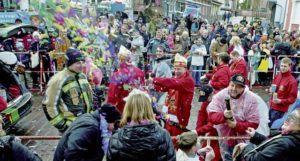Beyond the Bier is a cultural series based on German customs, traditions, and history in the Kaiserslautern Military Community. Get to know why your new neighbors celebrate, and commemorate certain holidays and observances — often with a wine or beer.
As the new year rolls in, one day in mid-February stands out. Around the Kaiserslautern Military Community, it’s called Fasching, but throughout German-speaking countries it can be referred to as Karneval or Fastnacht as well. So how do we as Americans fit into this celebration? Where did Fasching come from and why is it celebrated?
Fasching is celebrated before the Roman Catholic and Orthodox Church’s observance of Lent. Fasching is considered to be a Christian holiday, but the celebrations of Fasching can be seen in pagan festivals and rituals from Germanic tribes in ancient Germany. Those celebrations were designed to drive away evil spirits, encourage spring to come and good crops to grow.

Many cities hold large parades and festivals to commemorate the occasion. Mainz holds their large, traditional carnival on the Monday before Ash Wednesday. Their parade is the second-largest one in Germany, while Koln’s is the largest festival. The cities of Trier and Koblenz also host large parades. Attendees are encouraged to dress up however they desire. From cowboys to hippies you’ll see many different costumes during these festivals and floats designed to satirically mimic politicians will roll down the street. Ramstein-Miesenbach holds their parade on Fat Tuesday. This year’s celebration will take place Feb. 25 at 2:30 p.m.
During celebrations held long ago, food and drink was widely consumed and normal city ordinances and order were suspended. Some notable examples were the keys to the city being given to jesters or fools, women ceremoniously ruling the town, noisy parades and masquerade balls.
The term Fasching can be traced back to the 13th century. It’s a derivation of the modern German word, fastenschank, which refers to the last serving of alcohol before Lent. Although the exact history of Fasching is unclear, references date back to the early 13th century. Going back to 1234, city-wide celebrations occurred in Cologne, Mainz, and Speyer.
While Fasching season officially starts on Nov. 11 at 11:11 a.m., the parades and balls typically occur during the last few days before Lent begins. The celebration ends at midnight on Ash Wednesday.
Those interested in being involved with this year’s festivities should contact their local Rathaus or town hall to get more information about Fasching celebrations in their area.







